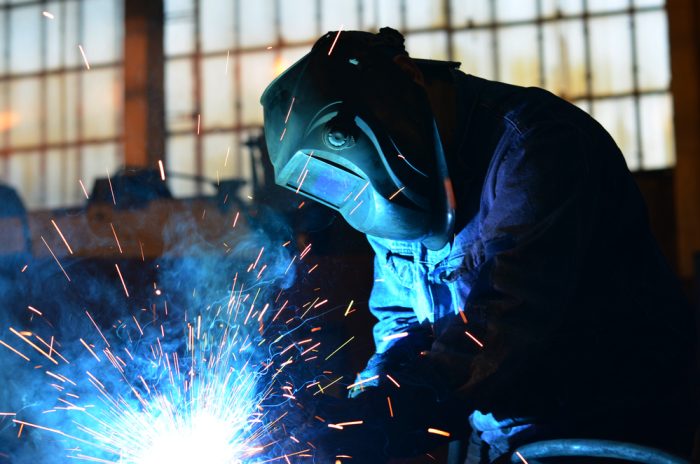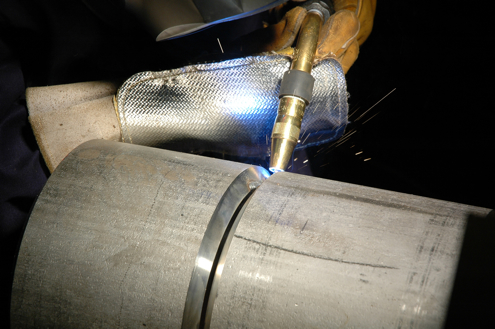Everything about Welding: Key Insights Into Techniques and Finest Practices for Success
Welding incorporates a variety of methods, each fit for details products and applications. Comprehending these methods, such as GMAW, SMAW, and TIG, is important for achieving suitable results. Moreover, the ideal devices and safety techniques can not be forgotten. As preparation and repairing play critical roles in the welding procedure, grasping these elements can considerably boost the quality of the last item. What are the vital elements that guarantee an effective weld?
Recognizing Various Welding Methods
Welding methods encompass a variety of approaches, each fit to certain applications and materials. Among the most common techniques are Gas Metal Arc Welding (GMAW), Secured Metal Arc Welding (SMAW), and Tungsten Inert Gas Welding (TIG) GMAW, also recognized as MIG welding, is popular for its rate and convenience, making it ideal for slim materials. SMAW, or stick welding, is favored for its simpleness and effectiveness in outdoor environments, specifically with thicker metals. TIG welding offers precision and control, making it suitable for complex work and non-ferrous steels (Montana Mobile Welding and Repair Belgrade Welding). Each technique has its distinct benefits and factors to consider, allowing welders to pick the finest technique based upon the job's needs, product kind, and wanted end results. Recognizing these techniques is vital for effective welding
Vital Welding Devices and Tools
While various welding methods call for specific skills, the ideal equipment and devices are similarly necessary for attaining top quality results. Necessary welding tools includes welding makers, which vary depending upon the method-- such as MIG, TIG, or stick welding. Protective equipment, consisting of handwear covers, safety helmets, and aprons, guarantees safety and comfort during the procedure. Furthermore, clamps and components aid protect materials in position, making certain accuracy in welds. Consumables like welding poles, cable, and securing gas are likewise essential components that affect the high quality of the weld. Tools such as cutters and grinders facilitate surface prep work and post-weld completing, adding to an expert end result. Purchasing high-quality devices ultimately enhances the performance and efficiency of welding tasks.
Security Practices in Welding
Correct safety practices are necessary in the welding industry to protect employees from potential dangers. Welders must put on ideal personal protective equipment (PPE), including helmets with proper shading, gloves, and flame-resistant clothing. Sufficient air flow is important to lower exposure to harmful fumes and gases generated during the welding procedure. In addition, employees should be educated in the right handling of welding devices to avoid mishaps. Fire precaution, such as maintaining flammable products away from the welding area and having fire extinguishers easily available, are essential. Normal evaluations of devices and offices can assist determine prospective hazards prior to they result in mishaps. By sticking to these safety and security practices, welders can produce a safer working environment and decrease dangers connected with their profession.
Readying Materials for Welding
Preparing products for welding is an important step that significantly influences the quality and integrity of the final item (Welding). Proper prep work entails cleansing the surface areas to get rid of contaminants such as oil, dirt, and rust, which can jeopardize the weld. Techniques such as grinding, fining sand, or using solvents are commonly utilized to accomplish a tidy surface. Additionally, guaranteeing that the materials mesh comfortably is crucial; spaces can lead to weak welds. It's additionally important to consider the positioning and positioning of the components, as this will influence the simplicity of welding and the last end result. Selecting the appropriate filler material and guaranteeing compatibility with the base steels is necessary for achieving strong, sturdy welds.
Tips for Getting High-Quality Welds
Attaining high-grade welds calls for focus to information and adherence to best practices throughout the welding procedure. Appropriate joint preparation is necessary, making certain surfaces are tidy and totally free from contaminants. Picking the suitable filler product and welding strategy based on the base steels is crucial for optimal bonding. Preserving constant traveling rate and angle while welding can stop defects and promote uniformity. Furthermore, controlling warm input is necessary; extreme warmth can lead to warping and compromised joints. If essential, regularly inspecting the welds throughout the process his comment is here enables for instant changes. Lastly, using appropriate post-weld treatments, such as cleaning and tension alleviation, can boost the resilience and stability of the weld, eventually guaranteeing a successful result.
Troubleshooting Typical Welding Issues
Welding often presents obstacles that can affect the quality and honesty of the end product. Usual issues such as porosity, inconsistent weld beads, and getting too hot can occur, each needing specific troubleshooting techniques. Comprehending these issues is vital for welders to enhance their skills and achieve optimal outcomes.
Porosity Problems Discussed
Although porosity can commonly be forgotten, it stays a vital issue in welding that can jeopardize the honesty of a completed item. Porosity describes the visibility of little gas pockets within the weld grain, which can lead and deteriorate the joint to premature failure. This problem normally arises from pollutants, dampness, or improper securing gas coverage throughout the welding procedure. To alleviate porosity, welders need to verify that the base materials are clean and completely dry, utilize appropriate protecting gases, and preserve constant welding parameters. On a regular basis inspecting the devices and atmosphere can likewise aid identify prospective concerns prior to they materialize in the weld. Resolving porosity effectively is necessary for achieving strong, sturdy welds that meet top quality standards.

Inconsistent Weld Beads
Inconsistent weld beads can significantly influence the quality and stamina of an ended up product. Different aspects contribute to this issue, including incorrect travel rate, incorrect amperage setups, and irregular electrode angles. When the welder relocates too rapidly, a grain may show up narrow and do not have penetration, while moving too slowly can trigger excessive buildup. Additionally, making use of the wrong amperage can lead to either damaging or too much spatter, both of which concession weld integrity. The welder's method, such as inconsistent lantern movement, can likewise lead to irregular bead look. To minimize these issues, welders ought to concentrate on keeping steady, regulated movements and making sure proper equipment setups to attain harmony in their welds. Consistency is key to achieving dependable and solid welds.
Getting Too Hot and Bending Issues
Too much heat during the welding process can result in substantial getting too hot and buckling problems, impacting the structural stability of the workpiece. These issues typically materialize as distortion, which can jeopardize placement and fit-up, making further assembly testing. Factors adding to overheating consist of the choice of welding criteria, such as voltage and take a trip speed, in addition to a knockout post the sort of material being welded. To reduce these concerns, welders should keep regular traveling speed and proper warm input while checking the work surface temperature. In addition, preheating or post-weld heat therapy can assist minimize stresses triggered by rapid cooling - Montana Mobile Welding and Repair Welding. Routine examination and adherence to ideal methods are vital in preventing getting too hot and guaranteeing the longevity and reliability of bonded structures
Often Asked Questions
What Are the Career Opportunities in the Welding Sector?
The welding industry supplies varied career chances, including positions as welders, inspectors, designers, and educators. Professionals can function in production, building and construction, aerospace, and auto sectors, taking advantage of strong need and affordable salaries in different duties.
Exactly How Can I Improve My Welding Rate Without Compromising High Quality?
To enhance welding rate without giving up quality, one should practice effective strategies, keep devices, optimize setups, and improve hand-eye control. Routine training and looking for feedback can also significantly add to achieving faster, top notch welds.
What Qualifications Are Available for Welders?
Numerous certifications exist for welders, including those from the American Welding Culture (AWS), the National Center for Building And Construction Education And Learning and Research (NCCER), and different industry-specific companies. These qualifications improve employability and demonstrate ability proficiency.
Exactly How Does Welding Affect the Characteristics of Metals?
Welding affects the residential or commercial properties of metals by modifying their microstructure, which can bring about changes in solidity, toughness, and ductility. Warm input and cooling prices throughout the process considerably affect these material features.
Can I Bonded Dissimilar Metals Together?
